In Illumination: From Divine to Sacred | From Drinking to Savoir-boire | From Vineyard to Port
From Divine to Sacred: Nectar of the Gods, The Blood of the Grapes, and the Blood of Christ

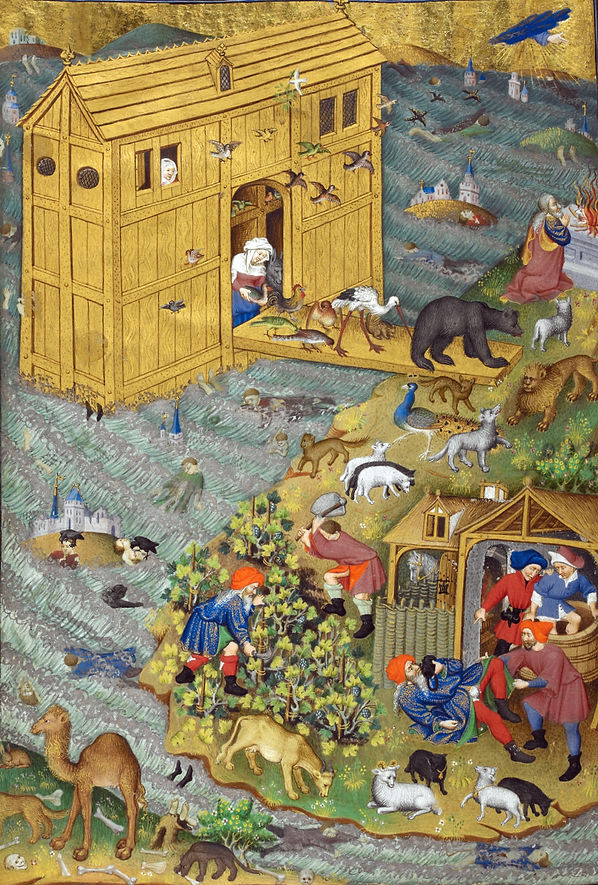
DEBARKING FROM NOAH'S ARK AND THE DRUNKENNESS OF NOAH - detail
Bedford Hours (Book of Hours), ca. 1430
British Library, London
The Bedford Hours is in fact a ‘Book of Hours’ from Paris, illuminated in the city during the first third of the fifteenth century. Most of the miniatures have been attributed to an anonymous master and members of his workshop, now known collectively as ‘the Bedford Master’. The manuscript belonged to John of Lancaster, Duke of Bedford. He was the third son of the English king Henry IV, and became Regent of the Kingdom of France in 1422, after the death of his brother Henry V, whose son and heir – the future Henry VI – was only nine months old.
In 1423, at Troyes, John of Lancaster married Anne of Burgundy, daughter of the Duke of Burgundy Jean the Fearless, his ally against the Valois side in the Hundred Years War. The manuscript must have been commissioned at this time. In 1430, Anne of Burgundy and John of Lancaster gave the work to the young Henry VI, now aged nine, while he was living in Rouen and awaiting his coronation as King of France. The military successes of Joan of Arc put paid to this, of course.
This miniature, entitled Debarking from Noah’s Ark, also evokes the Drunkenness of the great patriarch during the harvest and pressing of the grapes.
NECTAR OF THE GODS

BACCHUS Livre des échecs amoureux moralisés, 1496/98 - BnF, Paris

BACCHUS, THE GOD OF WINE Livre des échecs amoureux, Hainaut, 15th Century - BnF, Paris / 2

BACCHUS AND HIS FOLLOWERS DRINKING WINE Livre de la Reine, Epitre d'Othea, ca. 1410/11 - BL, London / 3
> Click on the icons for a closer look at the artworks
2. "Bacchus was called a god by the Ancients because of the marvelous properties of wine and its various effects on the human body, according to the type of wine, the type of person drinking and the quantity in which it is drunk. [...] The fact that this god was represented as a young child with feminine features symbolises well the nature of wine, because of the way that young children are happy, optimistic and generous by nature [...] taken in moderation, wine makes man joyful and optimistic in much the same way [...] Furthermore, as the female face is gracious, soft, amiable and pleasant to behold, wine drunk in moderation is agreeable, pleasant, soft and amiable, especially to men. The female face draws in the beholder, and often deceives and maddens him so much that he refuses to turn away from the promised pleasure; wine attracts the drinker who, for the pleasure of it, only wants to drink, in much the same way. [...] The horns symbolise the bestiality of the excessive drinker, because overconsumption of wine can lead to the loss of reason and make the victim resemble a horned beast. The tiger, an animal that is deceptive, cruel and quick to the chase, shows us the fury and the violence to which wine can bring the drinker [...]” (Source: BNF).
3. Although the myth of Dionysus was known in the Middle Ages, it has left few traces for today’s researchers. Christine de Pisan describes him as a “black angel” and her view of the myth is overtly negative: "Au dieu Bacus point ne t'acordes / Car ses conditions sont ordes / Non vaillables en ses depors / Les gens fait transmuer en pors". (“Give thyself not to Bacchus / For his way is odious / Worthless in their disports / His people transform into hogs”).
THE BLOOD OF THE GRAPES IN THE OLD TESTAMENT
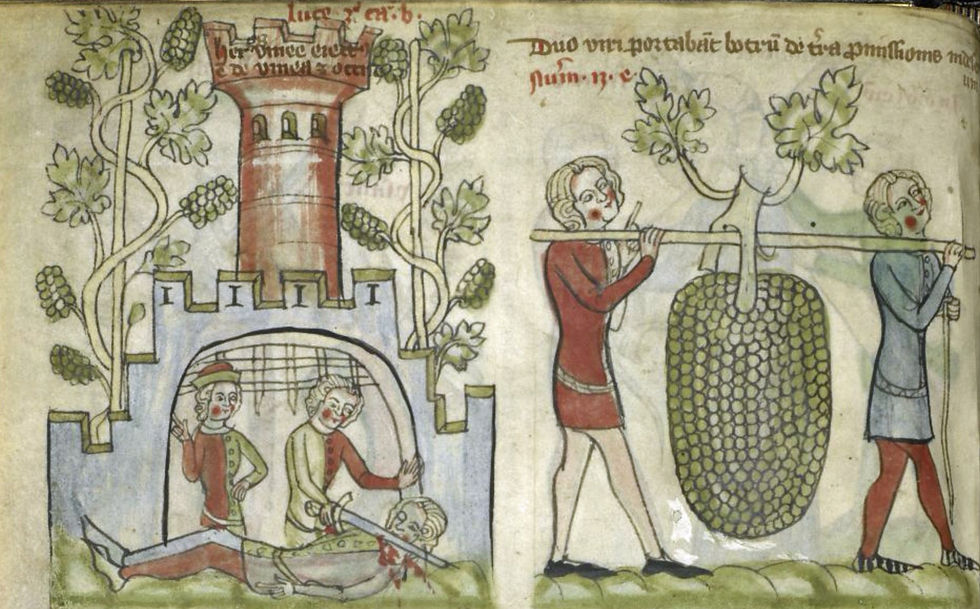
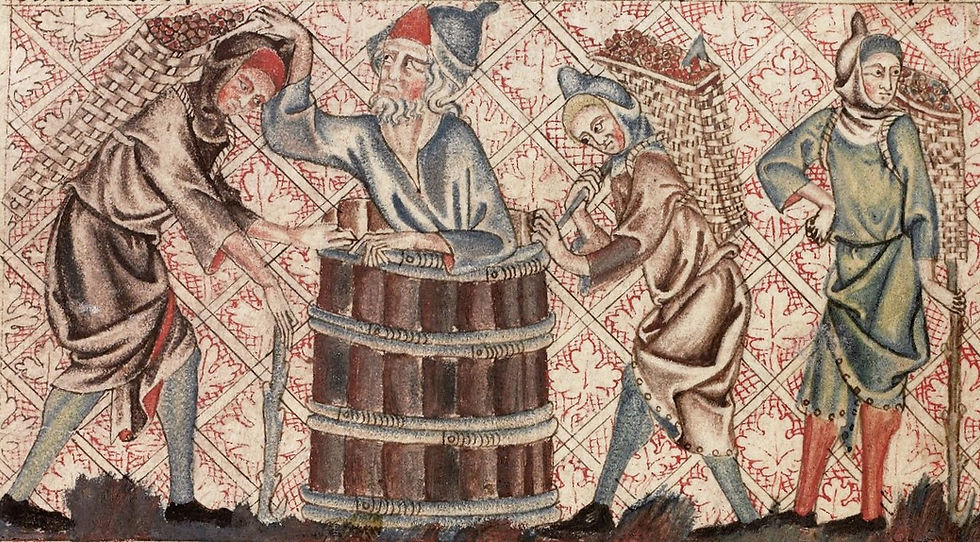
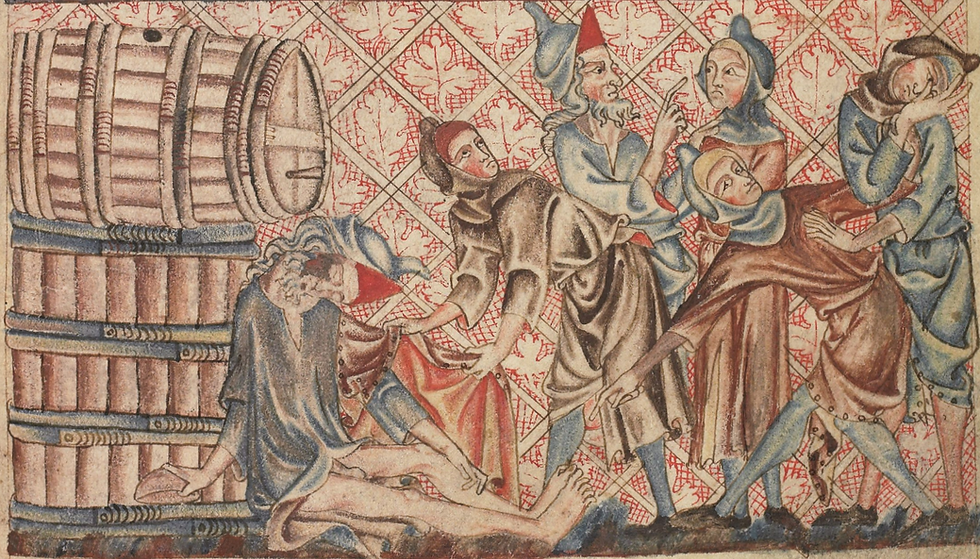

THE DRUNKENNESS OF NOAH Biblia Pauperum, ca. 1395-1400 - British Library, London

THE DRUNKENNESS OF NOAH Petrus Comestor, 1372 Koninklijke Bibliotheek, The Hague, The Netherlands / 2

NOAH WINEGROWING, THE DRUNKENNESS OF NOAH Miroir historial, Vincent de Beauvais, 1463 - BnF, Paris

BELSHAZZAR'S FEAST Petrus Comestor, 1372 Koninklijke Bibliotheek, The Hague, The Netherlands

BELSHAZZAR'S FEAST Utrecht Bible, 1430 - Koninklijke Bibliotheek, The Hague, The Netherlands

BELSHAZZAR'S FEAST Speculum Humanæ Salvationis, 1450 - The Hague, The Netherlands
> Click on the icons for a closer look at the artworks
2. In this image it is not his genitals, but his buttocks that the drunken Noah inadvertently reveals to his sons. Ham is shown in pale blue, gesturing towards his father. To the left, Japhet – also in blue – lifts the sheet and sees Noah’s nakedness. In the centre Shem, whose red clothes contrast with those of his brothers, intervenes and tries to replace the covering.
THE BLOOD OF THE CHRIST IN THE NEW TESTAMENT AND CHRISTIAN ICONOGRAPHY

MARRIAGE AT CANA Illuminated Bible, 1197 - City Library, Amiens, France

MARRIAGE AT CANA Tres Belles Heures de ND du duc de Berry, 1380s - BnF, Paris / 2

MARRIAGE AT CANA Roman de Dieu et sa mère In the early 15th Century - City Library, Besançon, France

THE LAST SUPPER The Floreffe Bible, ca. 1165 - British Museum, London

THE LAST SUPPER 12th century, North of England Bodleian Library, Oxford University, United Kingdom

THE LAST SUPPER The Speyer Evangeliarium, Codex Bruschal, 1220 - Karlsruhe

THE LAST SUPPER Lectionary, 1227/74, Austria - Morgan Library, New York

THE LAST SUPPER 13th century, Bruges - Bodleian Library, Oxford University, Unite Kingdom

LAST SUPPER Livre d'heures de Madame Marie, 1285 - BnF, Paris

THE LAST SUPPER For the Sion Covent use, 1505 - Bibliothèque Mazarine, Paris
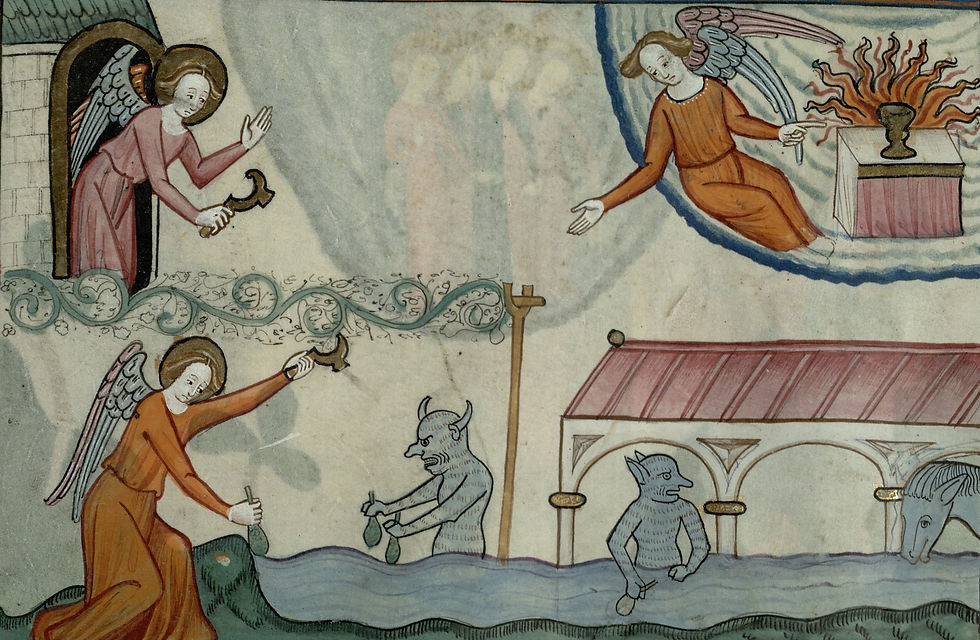
THE TRINITY APOCALYPSE ca. 1250/60 - The Trinity College Library, Cambridge, UK / 11 Speculum humanæ salvationis, ca. 1360 - Darmstadt, Germany

THE TRINITY APOCALYPSE ca. 1250/60 - The Trinity College Library, Cambridge, UK / 12

THE HARVEST OF NATIONS (THE HARVEST OF THE EARTH) Revelation, ca. 1450 - City Library, Lyon, France / 13

CHRIST IN THE WINEPRESS ce. 1400/10 - ONB, Vienna, Austria / 14

CHRIST IN THE WINEPRESS Livre de prière d'Ulrich de Montfort, ca. 1515/20 - Vienna, Austria
>Click on the icons for a closer look at the artworks
2. The Marriage at Cana, included in the Tres Riches Heures de Notre-dame du Duc de Berry, illustrates the pages of Vespers of the Virgin. The scene shows Christ’s first miracle: the transformation of water into wine. In line with tradition, the bride is seated rigidly in the centre of the scene, her parents to her right. To the left, Mary prays while watching her son blessing the wine. The groom is nowhere to be seen.
11 to 13. The Harvest of the Earth or The Harvest of Nations refers back to a passage from the Book of Revelations (14:18-20): “... And another angel came out from the altar, who had power over fire, and he cried with a loud cry to him who had the sharp sickle, saying ‘Thrust in your sharp sickle and gather the clusters of the vine of the earth, for her grapes are fully ripe.’ So the angel thrust his sickle into the earth and gathered the vine of the earth, and threw it into the great winepress of the wrath of God. And the winepress was trampled outside the city, and blood came out of the winepress, up to the horses’ bridles, for one thousand six hundred furlongs.”(cf. The Harvest of the Earth by Jacobello Alberegno).
14. The Mystical Winepress shows Christ being crushed like a bunch of grapes. This image emerged at a time when the ideal of self-sacrifice played a major role in Christian devotion. It appears very rarely in manuscript miniatures.
GALLERIES IN ILLUMINATION
> Wine and Painting > In Illumination > From Divine to Sacred




